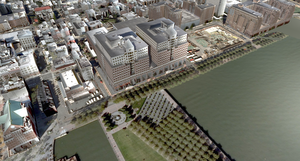Information
- Publication Type: Master Thesis
- Workgroup(s)/Project(s):
- Date: October 2010
- TU Wien Library:
- First Supervisor: Michael Wimmer

Abstract
Virtual texturing (as presented by Mittring in ’Advanced Virtual Texture Topics’ and in
distinction to clipmap-style systems, to which this term is also applied) is a solution to
the problem of real-time rendering of scenes with vast amounts of texture data which
does not fit into graphics or main memory. Virtual texturing works by preprocessing
the aggregate texture data into equally-sized tiles and determining the necessary tiles
for rendering before each frame. These tiles are then streamed to the graphics card and
rendering is performed with a special virtual texturing fragment shader that does texture
coordinate adjustments to sample from the tile storage texture.
A thorough description of virtual texturing and related topics is given, along with an
examination of specific challenges including preprocessing, visible tile determination,
texture filtering, tile importance metrics and many more. Tile determination in view
space is examined in detail and an implementation for compressing the resulting buffer
in OpenCL is presented. Rendering with correct texture filtering from a texture which
contains de-correlated texture tiles is attained by using tile borders with specific coordinate
adjustment and gradient correction in the fragment shader.
A sample implementation is described and serves to provide results concerning performance
and correctness with different settings and architecture choices. Integration into
Open Scene Graph for usage within a hybrid point-cloud / polygonal renderer enables
rendering of high resolution paintings within catacombs modeled with point clouds. Another
application is presented, the real-time display of a highly detailed model of New
York with more than 60 GB textures.
Quantitative analysis reveals that frame-rates above 200 FPS are attainable on complex
scenes with multi-million polygons even with outdated hardware. At the same time
quality remains high, results indicate that ”fallbacks”, that occur when a needed texture
tile is not ready in time, occur only for 0.01% of the pixels on average. These results
show that virtual texturing can be a competitive solution for games, scientific and industrial
applications, allowing for real-time rendering of scenes that could not be displayed
previously, while maintaining acceptable visual quality.
Additional Files and Images
Additional images and videos
Additional files
Weblinks
No further information available.
BibTeX
@mastersthesis{Mayer-2010-VT,
title = "Virtual Texturing",
author = "Albert Julian Mayer",
year = "2010",
abstract = "Virtual texturing (as presented by Mittring in ’Advanced
Virtual Texture Topics’ and in distinction to
clipmap-style systems, to which this term is also applied)
is a solution to the problem of real-time rendering of
scenes with vast amounts of texture data which does not fit
into graphics or main memory. Virtual texturing works by
preprocessing the aggregate texture data into equally-sized
tiles and determining the necessary tiles for rendering
before each frame. These tiles are then streamed to the
graphics card and rendering is performed with a special
virtual texturing fragment shader that does texture
coordinate adjustments to sample from the tile storage
texture. A thorough description of virtual texturing and
related topics is given, along with an examination of
specific challenges including preprocessing, visible tile
determination, texture filtering, tile importance metrics
and many more. Tile determination in view space is examined
in detail and an implementation for compressing the
resulting buffer in OpenCL is presented. Rendering with
correct texture filtering from a texture which contains
de-correlated texture tiles is attained by using tile
borders with specific coordinate adjustment and gradient
correction in the fragment shader. A sample implementation
is described and serves to provide results concerning
performance and correctness with different settings and
architecture choices. Integration into Open Scene Graph for
usage within a hybrid point-cloud / polygonal renderer
enables rendering of high resolution paintings within
catacombs modeled with point clouds. Another application is
presented, the real-time display of a highly detailed model
of New York with more than 60 GB textures. Quantitative
analysis reveals that frame-rates above 200 FPS are
attainable on complex scenes with multi-million polygons
even with outdated hardware. At the same time quality
remains high, results indicate that ”fallbacks”, that
occur when a needed texture tile is not ready in time, occur
only for 0.01% of the pixels on average. These results show
that virtual texturing can be a competitive solution for
games, scientific and industrial applications, allowing for
real-time rendering of scenes that could not be displayed
previously, while maintaining acceptable visual quality.",
month = oct,
address = "Favoritenstrasse 9-11/E193-02, A-1040 Vienna, Austria",
school = "Institute of Computer Graphics and Algorithms, Vienna
University of Technology ",
URL = "https://www.cg.tuwien.ac.at/research/publications/2010/Mayer-2010-VT/",
}

 poster
poster Thesis
Thesis


